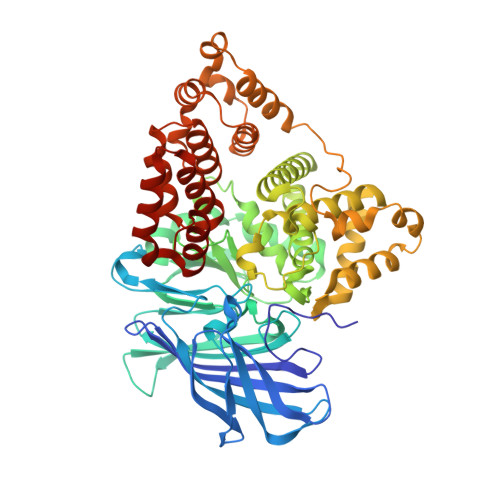Crystal Structures of Leukotriene A4 Hydrolase in Complex with Captopril and Two Competitive Tight-Binding Inhibitors
Thunnissen, M.M.G.M., Andersson, B., Wong, C.-H., Samuelsson, B., Haeggstrom, J.Z.(2002) FASEB J 16: 1648
- PubMed: 12207002
- DOI: https://doi.org/10.1096/fj.01-1017fje
- Primary Citation of Related Structures:
2VJ8 - PubMed Abstract:
Leukotriene (LT) A4 hydrolase/aminopeptidase is a bifunctional zinc enzyme that catalyzes the final step in the biosynthesis of LTB4, a potent chemoattractant and immune modulating lipid mediator. Here, we report a high-resolution crystal structure of LTA4 hydrolase in complex with captopril, a classical inhibitor of the zinc peptidase angiotensin-converting enzyme. Captopril makes few interactions with the protein, but its free thiol group is bound to the zinc, apparently accounting for most of its inhibitory action on LTA4 hydrolase. In addition, we have determined the structures of LTA4 hydrolase in complex with two selective tight-binding inhibitors, a thioamine and a hydroxamic acid. Their common benzyloxyphenyl tail, designed to mimic the carbon backbone of LTA4, binds into a narrow hydrophobic cavity in the protein. The free hydroxyl group of the hydroxamic acid makes a suboptimal, monodentate complex with the zinc, and strategies for improved inhibitor design can be deduced from the structure. Taken together, the three crystal structures provide the molecular basis for the divergent pharmacological profiles of LTA4 hydrolase inhibitors. Moreover, they help define the binding pocket for the fatty acid-derived epoxide LTA4 as well as the subsites for a tripeptide substrate, which in turn have important implications for the molecular mechanisms of enzyme catalyses.
Organizational Affiliation:
Department of Biochemistry, University of Stockholm, Arrhenius Laboratories A4, S-106 91 Stockholm, Sweden.



















